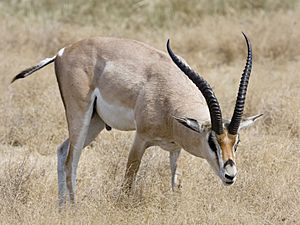Grant's gazelle facts for kids
The Grant's gazelle (Nanger granti) is a type of gazelle that lives in many parts of East Africa. Its Swahili name is Swala Granti. This animal was named after an explorer called James A. Grant.
Quick facts for kids Grant's gazelle |
|
|---|---|
 |
|
| Conservation status | |
| Scientific classification | |
| Kingdom: | |
| Phylum: | |
| Class: | |
| Order: | |
| Family: | |
| Subfamily: |
Antilopinae
|
| Genus: | |
| Binomial name | |
| Nanger granti (Brooke, 1872)
|
|
Contents
About Grant's Gazelles
The Grant's gazelle stands about 75–95 cm (30–37 in) tall. That's roughly the height of a 12 to 15-year-old kid. Female gazelles weigh between 35 and 50 kg (77 and 110 lb). Males are heavier, weighing between 50 and 80 kg (110 and 180 lb).
Their fur is a light beige-orange color on their backs. Their bellies are white. Grant's gazelles look a bit like Thomson's gazelles. However, you can tell them apart by their different horn shapes. Grant's gazelles are also known for being very fast runners.
Where They Live
Grant's gazelles live in East Africa. They prefer open grassy plains and shrublands. They are very good at living in dry areas. This is because they get most of their water from the plants they eat.
Life and Habits
Grant's gazelles live in East Africa. They like open grassy plains and shrublands. They avoid areas with tall grass. This is because tall grass makes it hard to see predators. They can also live in dry, semi-desert areas. They get water from eating leafy plants, especially when it's dry.
These gazelles are migratory. This means they travel from place to place. But they move in the opposite direction of other animals. Animals like Thomson's gazelles, zebras, and wildebeest need more water. Grant's gazelles can survive on plants in dry areas. This means they don't have much competition for food.
Predators
The main predators of Grant's gazelles are cheetahs and wild dogs. Humans also hunt gazelles. In the Serengeti, cheetahs often hunt Thomson's gazelles more. But in Nairobi National Park, Grant's gazelles are a more important food source for cheetahs. Young gazelles, called fawns, are often hunted by jackals.
Social Life
Grant's gazelles are social animals. They live in groups. They are also territorial and migratory. Female gazelles, called does, have home areas that overlap. But only male gazelles, called bucks, claim territories. Male gazelles will try to keep all females that enter their territory.
When a female is ready to mate, the dominant male guards her closely. He stops other males from mating with her. If a female tries to leave, he will gently herd her back. Usually, the male just standing near her is enough to keep her from leaving.
Young males and males without territories form "bachelor groups." New members must show they are strong to join. But these groups are not very strict. Members can leave whenever they want.
Older, larger males with thick horns are more likely to get a territory. Fights between adult males are usually solved by showing off. The bucks circle each other. They swing their necks from side to side. This shows how strong their necks are. Neck strength is important in a real fight. The male who cannot keep up usually gives up. Gazelles with similar neck strength are more likely to fight. Young males fight more often than older ones. Stronger males can often just chase away weaker ones without a fight.
Diet
Grant's gazelles eat both plants and grass. They are called "mixed feeders." On average, about 65% of their diet is leafy plants. The other 34% is grass. How much rain there is affects what they eat.
They get most of their water from the plants they eat. So, they don't need to drink water very often. This allows them to stay on the plains even after the rainy season ends. From July to September, they move into dense bushes. They wait there for the next rains. They will eat tough plants and red oats. Other animals usually avoid these plants. This helps the gazelles survive in the bushes during the dry season. During the dry season, they mainly eat plants with two seed leaves, called dicotyledons. In the wet season, they eat more grass.
Reproduction
Grant's gazelles can start having babies when they are about 18 months old.
A female gazelle is pregnant for about 198 days.
Most babies are born in January and February. A mother gazelle will leave her group to find a safe, hidden place to give birth. Mothers nurse their fawns four times a day.
For the first few days, baby gazelles cannot move much. So, the mother stays very close. When the fawn can walk, it leaves with its mother to find a group. Around this time, fawns will start playing with other young gazelles.
A gazelle stops drinking its mother's milk at six months old. But it will stay with its mother until it is a teenager.
Images for kids
-
A skull of a male Grant's gazelle. This one is at the Smithsonian National Museum of Natural History in Washington D.C..
See also
 In Spanish: Gacela de Grant para niños
In Spanish: Gacela de Grant para niños









